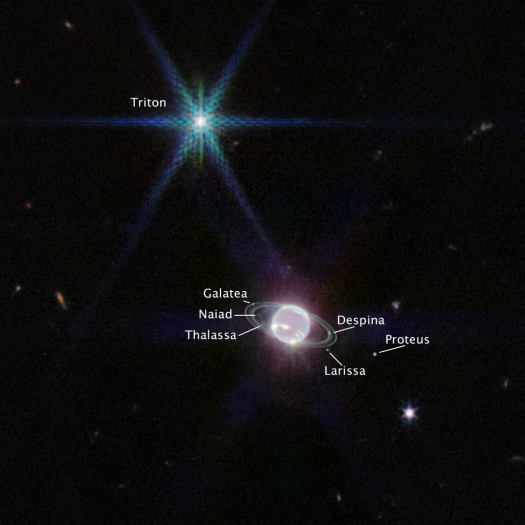
RELATED: James Webb Space Telescope captures stunning new image of Cartwheel Galaxy To do this, Webb has a much larger primary mirror than Hubble - 2.7 times larger in diameter - which gives it more light-gathering power. Specifically, Webb is designed to peer deeper into space to see the earliest stars and galaxies that formed in the universe and to look deep into nearby dust clouds to study the formation of stars and planets, NASA says. The James Webb Space Telescope is Hubble’s bigger, more powerful successor. The Hubble Space Telescope was launched into orbit by space shuttle Discovery in 1990, helping scientists to better understand how planets and galaxies form with its own awe-inspiring images. How does James Webb Space Telescope compare to Hubble Space Telescope?
NEPTUNE JWST UPDATE
NASA shared additional images from the $10 billion telescope’s initial outward gazes, including two images of nebulas where stars are born and die in spectacular beauty and another shot showing an update of a classic image of five tightly clustered galaxies that dance around each other. NASA astrophysicist shares details on set of James Webb Space Telescope images At that extreme distance, the Sun is so small and faint that high noon on Neptune is similar to a dim twilight on Earth," NASA said.Īdditional studies of both Neptune and Triton are planned for the James Webb Space Telescope in the coming year, according to researchers. "Neptune orbits in one of the dimmest areas of our Solar System. It takes 164 years to make a complete orbit around the Sun. Neptune was first discovered in 1846, and is located 30 times farther from the Sun than Earth. RELATED: NASA spacecraft set to intentionally crash into an asteroid to help save Earth NASA noted that a thin line of brightness circling Neptune's equator could be a "visual signature of global atmospheric circulation that powers Neptune’s winds and storms." "Such methane-ice clouds are prominent as bright streaks and spots, which reflect sunlight before it is absorbed by methane gas." "In fact, the methane gas is so strongly absorbing that the planet is quite dark at Webb wavelengths except where high-altitude clouds are present," researchers wrote. While Neptune's methane gas makes the planet appear blue in Hubble Space Telescope and Voyager 2 photos, the James Webb Space Telescope uses infrared light that can't be seen by the human eye, so Neptune does not appear blue in its image. However, the Webb Telescope's Near-Infrared Camera captures objects in the near-infrared range from 0.6 to 5 microns, so Neptune does not appear blue in its image. Compared to its neighboring gas giants, Jupiter and Saturn, Neptune is much richer in elements that are heavier than hydrogen and helium, NASA said.Īt visible wavelengths in Hubble Space Telescope images, Neptune appears blue due to small amounts of gaseous methane. Neptune is characterized as an ice giant due to its interior chemical make-up.

RELATED: NASA's Mars Perseverance rover finds diversity, hints of microbial life in ancient lake bed rocks

Triton orbits Neptune in a "bizarre backward (retrograde) orbit, leading astronomers to speculate that this moon was actually a Kuiper Belt object that was gravitationally captured" by the planet.


 0 kommentar(er)
0 kommentar(er)
